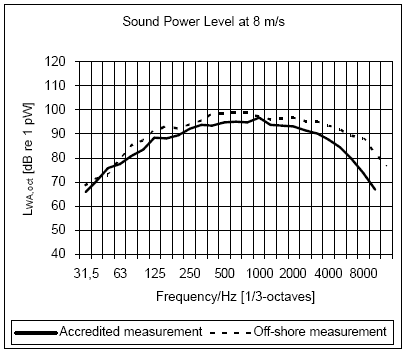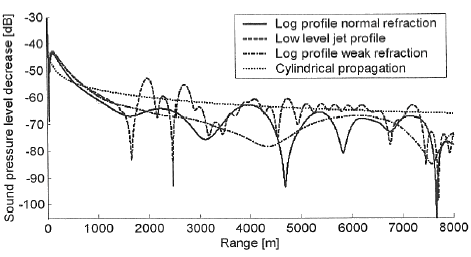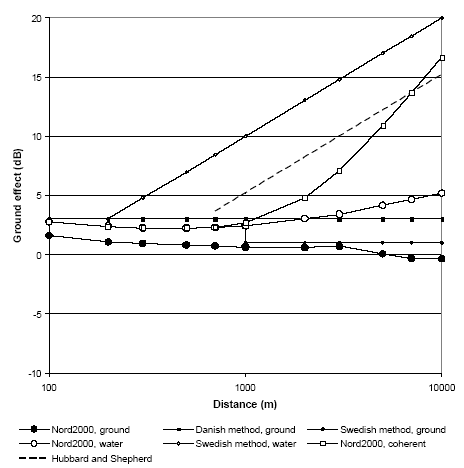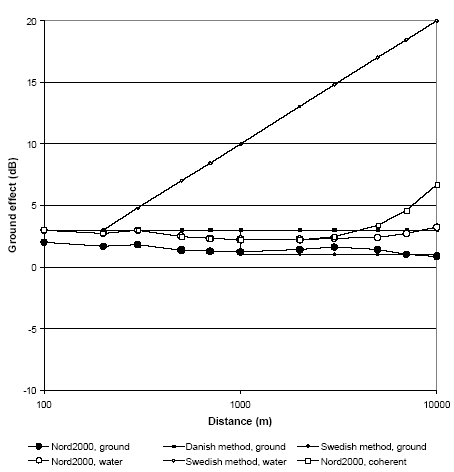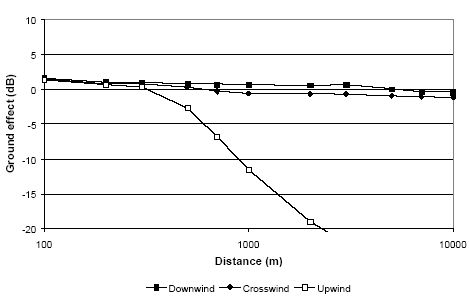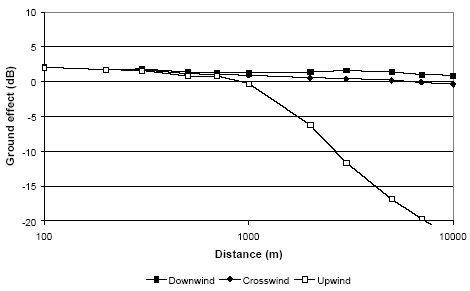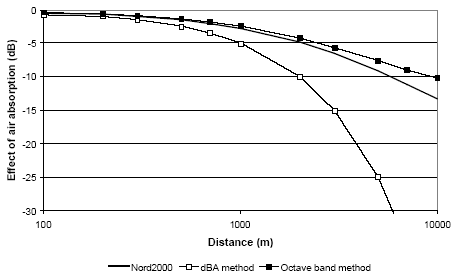|
Environmental Project no. 1016, 2005 Noise from offshore wind turbinesContents1 Noise emission measurements for offshore wind turbines: Measurement Procedure 3 Sound Propagation from Offshore Wind Turbines
ForordFormålet med det gennemførte projekt er at opnå en metode til måling af støjemission fra offshore vindmøller. Metoden skal give resultater, der er sammenlignelige med tilsvarende resultater opnået i henhold til IEC 61400-11:2002 for vindmøller placeret på land. Der er gennemført en enkelt offshore måling for at prøve metoden af i praksis. Derudover er der lavet en gennemgang af modeller for støjudbredelse offshore. ForewordThe purpose of the project is to establish a method for noise emission measurements for wind turbines on offshore locations. The method shall give results that can be compared with similar results achieved according to IEC 61400-11:2002 for land based wind turbines. A single offshore measurement has been made to test the method. In addition a survey of models for noise propagation from offshore wind turbines has been made. Sammenfatning og konklusionerOver hele verden fastlægges vindmøllers støjbelastning af omgivelserne gennem støjberegninger baseret på lydeffektniveauer bestemt i henhold til f.eks. [1]. For store vindmøller og store beregningsafstande er der en tendens til at nogle af beregningsmodellerne, der er udviklet til industri støj og mindre afstande giver forkerte resultater. Vindmøllerne bliver stadig større og flytter ud på vandet. Nogle offshore projekter vil blive placeret relativt tæt på kystlinjer med boligområder eller rekreative områder, og miljøpåvirkningen fra f.eks. støj kan vise sig at være af betydning. Afstanden fra offshore vindmølleparker kan variere fra nogle få kilometer som Middelgrunden udfor Københavns Havn til mere end 10 kilometer som Horns Rev vest for Blåvandshuk i Jylland. Støjudbredelse fra offshore vindmøller er forskellig fra lydudbredelsen for landbaserede vindmøller. På grund af refleksioner i den akustisk hårde havoverflade dæmpes støjen mindre med afstanden end støj, der udbredes over bløde græsmarker, og det, der synes at være en tilstrækkelig afstand for en vindmøllepark på land, kan vise sig ikke at være det for en offshore vindmøllepark. Derfor er det vigtigt at være i stand til at fastlægge støjbelastningen fra offshore vindmølleparker på en sikker og entydig måde. Dette omfatter pålidelige støjberegninger og muligheden for at kontrollere de opgivne støjdata gennem målinger. Støjmålinger offshore er vanskeligere end på land, og det er nødvendigt at ændre monteringen af målemikrofonen fra en placering på en plade på jorden. DELTA har testet en alternativ metode, hvor mikrofonen er placeret på et skib 3-5 m over havoverfladen, og har fundet den anvendelig. Det største problem med metoden er, at baggrundsstøjen fra bølgeslag mod skibssiderne kan maskere møllestøjen og dermed umuliggøre målingerne. Før metoden kan anbefales som en generel metode, bør der gennemføres yderligere forsøgsmålinger under forskellige omstændigheder. Prædiktering af støj fra offshore vindmølleparker involverer store beregningsafstande. Dette medfører, at selv små unøjagtigheder i prædikteringsmodellerne kan få betydning. Terrænvirkningen er af størst betydning, men også luftabsorption ved lave frekvenser har betydning. Den Danske dB(A)-model, der antager hårdt reflekterende underlag, overestimerer niveauet af støj, der udbredes over land, men giver rimelige resultater offshore for afstande op til 500 m. I oktavbånds-versionen øges denne afstand til 2-5 kilometer. Modellen giver forkerte resultater ved store afstande på grund af multiple refleksioner i havoverfladen. Refleksionerne summerer op og fører til cylindrisk spredning af lydenergien. NORD2000 inkluderer denne effekt. Det er dog nødvendigt at få yderligere afklaret, ved hvilke afstande og frekvenser effekten sætter ind, dvs. hvornår der skiftes mellem koherent og inkoherent summering af refleksionerne. Luftabsorptionskoefficienter ved lave frekvenser bør inkluderes i alle modeller. For uskærmede forhold giver forskellige vindretninger og vindhastigheder kun lille variation i støjniveauet i medvindsretninger og kun lidt mere i tværvind. Ved beregning af det årlige middelstøjniveau bliver variationer i støjniveauet for varierende meteorologiske situationer vigtige. Summary and conclusionsNoise assessment of wind turbines through calculations based on sound power levels measured according to e.g. [1] is used world wide. With larger wind turbines and calculation distances some of the calculation models developed for industry noise tend to give erroneous results. The wind turbines are getting larger and are going offshore. Some offshore locations will be relatively close to coastlines with residential or recreational areas, and the environmental impact from e.g. noise can prove to be a subject to debate. The distances from offshore wind farms to the coastline can vary from a few kilometres, e.g. Middelgrunden outside Copenhagen Harbour, to more than 10 km, e.g. Horns Rev west of Blåvandshuk in Jutland. Noise propagation from offshore wind turbines is different from propagation from land based wind turbines. Due to reflections from the acoustically hard sea surface, the noise is reduced at a slower rate than sound propagating over acoustically soft grassland, and what is supposed to be a safe distance for a wind farm on land may not be so for offshore wind farms. For that reason it is important to be able to make valid noise assessments for offshore wind farms. This includes reliable noise calculations and the possibility to check the specified noise data through measurements. Noise measurements offshore are more difficult than on land, and it is necessary to change the mounting of the microphone from a position on a plate on the ground. DELTA has tested an alternative method where the microphone is placed on board a vessel 3 to 5 m above sea level and has found it applicable. The main problem with the method is that background noise from waves hitting the vessel may mask the noise from the wind turbine and make measurements impossible. A few more tests in different situations should be made before the method is recommended as a general method. Prediction of noise from offshore wind turbines involves propagation of noise over large distances. This means that small inaccuracies in the prediction models can become significant. Most important is the ground effect, but also air absorption at low frequencies has to be considered. The Danish dB(A) model assuming a hard ground overestimates the levels of noise propagating over ground, but gives reasonable results offshore for limited distances up to 500 m. In the octave band version the reliable distance extends to 2 to 5 kilometers. The models fail at large distances because of multiple reflections from the sea surface building up and leading to cylindrical spreading of the sound energy. NORD2000 includes this effect. It is, however, necessary to achieve a better understanding of at which distances and frequencies the effect of multiple reflections is active, that is when to change from coherent to incoherent summation of the reflections. Air absorption coefficients at low frequencies should be included in all models. For situations without screening different wind directions and wind speeds give only small variations in downwind directions and only slightly more in cross wind. When calculating the annual average noise level, variations in the noise level during varying meteorological situations become important. 1 Noise emission measurements for offshore wind turbines: Measurement ProcedureMeasurement of noise emission from offshore wind turbines cannot in general be made with the standardized and generally accepted method in IEC 61400-11:2002 [1]. Most often the waves are so high that it is not safe to leave a microphone on a reflecting plate floating on the surface of the sea, and the noise produced by even small waves hitting the reflecting plate may exceed the noise level produced by the wind turbine. Instead an alternative method has been proposed where the microphone moved from a position on a plate on the ground to a position 3 to 5 m above the sea surface. The direct sound from the wind turbine and the reflected sound from the surface of the sea are almost equal, and when the frequency band considered is wide enough, the reflection causes a doubling of the energy of the direct sound and a 3 dB increase in sound pressure level. Actually, this principle lies behind the standards for measurement of sound power level in a free field above a reflecting plane, e.g. the ISO 3740-series. The principle does not apply to determination of tone levels. Thus the proposed alternative method cannot be expected to give conclusive results regarding the tonality of the wind turbine noise. The method follows the general line of action in Statutory order No. 304 of 14th May 1991 "Noise from Wind Turbines" from the Danish Environmental Protection Agency [2] and in IEC 61400-11:2002 [1].The main exceptions from the standard are described below. The measurements are made with a microphone mounted onboard a vessel. The wind speed is determined from the power produced by the wind turbine and a calibrated power curve rather than a simple wind speed measurement. The sound power level as well as other acoustic parameters are determined at integer wind speeds from 6 to 10 m/s and not only at 8 m/s. The tonality is not considered. 1.1 Microphone positionThe microphone is placed 3 to 5 m above the surface of the sea, free of reflecting obstacles like ship cabin, hull, etc. A position 1 m to 2 m from the vessel is preferred, but for practical reasons a position nearer the bulwark rail of the vessel is acceptable. The microphone axis shall point towards the hub of the wind turbine. To obtain an adequate signal-to-noise ratio, the microphone shall be fitted with extra wind noise reducing equipment, e.g. a standard spherical windshield 10 cm in diameter supplied with a secondary wind shield as described in [3]. In Figure 1. the mounting of the microphone with a secondary windshield used for the wind turbine noise measurements is shown. Figure 1 Mounting of microphone on board the vessel. The microphone is supplied with an extra wind shield.
1.2 Anemometer positionAn anemometer is placed onboard the same vessel as the microphone and at a height of 10 m above sea level. The anemometer is only used for the background noise measurements. The anemometer is expected to give the correct wind speed at 10 m height due to the small roughness length of the surface, and hence the normalization suggested in [1] is not necessary. 2 Noise Measurements2.1 Loudspeaker measurementsThe proposed measurement setup with the microphone at a height of 3 to 5 m above the sea surface is expected to correspond to a measurement above a fully reflecting ground surface. Above a certain frequency the result of this is a +3 dB addition to the free field value. To test if this works in practice, a pink noise signal from a calibrated loudspeaker hanging from the nacelle was measured at the new reference position. The source height was 60 m, the microphone height was 3.5 m and the horizontal distance was 125 m. In Figure 2. the measured noise levels are compared to the calculated noise levels using the NORD2000 model and a simple model using spherical spreading + 3dB. The input data for the NORD2000 calculation is shown in Figure 4. Figure 2 Comparison of measured noise and calculated noise Figure 3 Comparison of Excess attenuation (sound pressure levels in excess of spherical spreading) for NORD2000 and + 3 dB Figure 4 Computation parameters applied in Nord 2000 to obtain the results shown in Figure 2 and Figure 3
Generally there is a good agreement between measurement and calculation as the overall A-weighted sound pressure levels are within 1 dB of each other. Above 500 Hz Spherical spreading + 3 dB and NORD2000 are almost identical. Between 100 Hz and 500 Hz NORD2000 fits the general behaviour of the measurements better than Spherical spreading + 3 dB. Figure 3 shows the large variation in the ground effect with deviations from +3 dB of up to 4 dB. Below 100 Hz the measurements are expected to be highly influenced by background noise, giving too high values. The background noise at the frequencies from 25 Hz to 80 Hz is estimated to be around 40 dB to 45 dB. The deviation in ground effect from + 3 dB in this region is up to 10 dB. The difference between NORD2000 and Spherical spreading + 3 dB is so small that for simplicity it is recommended to use Spherical spreading + 3 dB, when calculating the Apparent Sound Power Level from measurements. If however the noise from the wind turbine has a significant content of noise below 100 Hz, it would be more correct to use the NORD2000 correction for the ground effect. 2.1.1 Loudspeaker calibrationThe loudspeaker was calibrated through a measurement setup with a similar geometry as for the noise measurements. The loudspeaker was hanging from a ladder at a height of 4 m to the centre. Noise measurements were made with the microphone on the hard asphalt paved ground at a distance of 8 m. Thus, the directivity and the efficiency of the loudspeaker were included in the calibration. The sound power level of the loud speaker in 1/3-octave bands is shown in Figure 5. Figure 5 Sound power level of the loudspeaker in 1/3-octave bands 2.2 Wind Turbine Noise measurementsThe noise measurements were made at a 2MW wind turbine situated in interior Danish waters. The wind speeds were from 7 m/s to 10 m/s, and the wave height was app. 1 m. The microphone height was 3 m. The results of the measurements are given in Figure 6. Figure 6 Measurement results
The average difference between the total noise measurements and the regression line through the background noise measurements is 4.3 dB. According to [1] the difference shall be 6 dB or more. The background noise was generated by waves hitting the vessel. As the measurements were made at a location, where the wave height was rather small, this can prove to be a general problem with the method. The background noise can be reduced by using a microphone placed at a higher position or at a larger distance from the vessel. The measurement distance was at the outer limit of the range given in [1] i.e. R0 + 20 % = 125 m. If the shortest distance, R0 - 20% = 85 m, had been applied, the noise level from the turbine would be expected to be app. 2 dB higher, and the 6 dB difference criteria would have been met. Increasing the microphone height from 3 m to 5 m would give a smaller impact of the background noise. The background noise was dominated by wave noise, while wind induced noise in this case was negligible. In Figure 7 the background noise and the total noise at a wind speed of 8 m/s is given as 1/3-octave band spectra. Figure 7 Comparison of Total Noise and Background Noise in 1/3-octave band spectra
The results given as the Apparent Sound Power level of the measurements relative to the results from an accredited measurement for a land based wind turbine of the same make and type are given in Table 1. The offshore measurements are corrected for the background noise even though the 6 dB difference was violated. A second order regression is applied, as this was done in the accredited report to make a direct comparison possible.
Table 1. Apparent sound power level for the offshore wind turbine relative to results from an accredited measurement at a similar wind turbine on land. The value at 6 m/s has been extrapolated from a second order regression through the data points. The results of the offshore measurements are 1 dB to 3 dB above the results from the land based wind turbine. This difference is within what could be expected when comparing two different wind turbines of the same type on land. A comparison of the frequency distribution in 1/3-octave bands is shown in Figure 8. Figure 8 Comparison of sound power levels in 1/3-octave bands
2.3 CommentsThe results of the measurements indicate that it is possible to make noise measurements on offshore wind turbines according to the general principles in IEC 61400-11:2002 with a few changes.
where LAeq,c is the background corrected A-weighted sound pressure level R1 is the slant distance in meters from the rotor centre to the microphone and S0 is the reference area, S0 = 1 m2 The background noise from the waves hitting the vessel is the main problem. To reduce the influence of this, it is recommended to use the shortest allowable measurement distance given in the standard, i.e. R0 – 20 %, and use as high a microphone position as possible. 3 Sound Propagation from Offshore Wind Turbines
3.1 IntroductionThe purpose of this section is to illustrate the differences to be expected between sound propagation from offshore wind turbines and land-based wind turbines. The illustration is based on existing sound propagation models described in the literature and calculations made with these models for typical spectra of wind turbines as well as on other knowledge of sound propagation. 3.2 Literature on Sound Propagation ModelsThe sound propagation from offshore wind turbines is only described in the literature to a limited extent. In an earlier article of Hubbard and Shepherd [4] the basic aspects of sound propagation from land-based wind turbines are described. The article contains results from measurements of noise from wind turbines performed in a desert area where the sand surface will be hard at least at the low frequencies and thus correspond to a water surface. The article describes the effect of meteorological refraction by the formation of shadow zones in upwind and sound channelling at low frequencies in downwind. It is concluded that the measurements in downwind at high frequencies (630 Hz) show good correlation with spherical propagation (6 dB reduction per doubling of distance) plus air absorption, where measurements at low frequencies (8-16 Hz) show better correlation with cylindrical propagation (3 dB reduction per doubling of distance). Almost at the same time as the publication of [4] the Danish Ministry of Environment published "Bekendtgørelse om støj fra vindmøller" ("Government Order on Noise from Wind Turbines") [2] describing a method for determination of the sound pressure level at a height of 1.5 m above ground at the nearest neighbour. The sound pressure level is calculated according to [2] by Equation (1).
where LWA,ref is the sound power level of the turbine, l is the distance between the turbine base and the receiver, h is the hub height, and ΔLa is the air absorption. The number 8 in the equation indicates that the ground increases the sound pressure level by +3 dB relatively to free field corresponding to hard ground. According to [2] ΔLa can be calculated with a simple attenuation coefficient of 0.005 dB/m or with a little more advanced octave band method. In case of large propagation distances the two methods can result in considerable differences. In 1998 the EU Project JOR3-CT95-0065 on immission of noise from wind turbines [5] was finalized. The project dealt among others with the elaboration of a prediction method for the sound propagation and validation of the model with measurements of sound propagation from a number of wind turbines. For one wind turbine the sound propagation was over water. The acoustical principles used in the propagation model correspond by and large to the principles applied in Nord2000 ([9] and [10]), but the model is only valid for level ground, whereas Nord2000 is a general propagation model. The model gave good agreement with the measurements, but the measurements only cover distances up to 600 m and in the case with propagation over water only up to 350 m. In 2001 Naturvårdsverket in Sweden published a report [6] with a proposal for a Swedish prediction method for noise from wind turbines with sound propagation both over ground and water. The proposal was based on a literature study [7]. For land-based wind turbines and a propagation distance below 1000 m the A-weighted sound pressure level is calculated according to Equation (2), which corresponds to the Danish method given in Equation (1). The calculation of ΔLa also corresponds to the Danish method with a simple attenuation coefficient of 0.005 dB/m. For land-based wind turbines and a propagation distance above 1000 m the A-weighted sound pressure level is calculated according to Equation (3), which corresponds to the Danish method with a reduction of 2 dB (ground effect of +1 dB relatively to free field instead of +3 dB). The calculation of ΔLa in Equation (3) has a resemblance to the Danish octave band method, but the attenuation coefficients in the octave bands are not the same, and the method goes down to 63 Hz, where the Danish method ignores air absorption below 250 Hz. For offshore wind turbines and a propagation distance below 200 m the A-weighted sound pressure level is calculated according to the same method as used for land-based wind turbines in Equation (2). For propagation distances above 200 m the A-weighted sound pressure level is calculated according to Equation (4), where the calculation of ΔLa corresponds to the octave band method for land-based wind turbines with propagation distances of above 1000 m. The term 10log(r/200) in the equation means that the propagation gives an attenuation of 3 dB per doubling of distance instead of 6 dB (cylindrical instead of spherical propagation). In [6] it is stated that the prediction model is based on very few measurement data and produces the upper limit of the noise. This comment may suggest doubt as to whether cylindrical sound propagation already begins at distances of 200 m. Although not quite clear from the report, the Swedish method seems to be based on experiences from relatively low wind turbines (hub height of 20 to 40 m). Ground < 1000 m, water < 200 m:
Ground > 1000 m:
Water > 200 m:
In 2003 sound propagation from offshore wind turbines was theoretically treated in a PhD study [8]. The emphasis of the study is laid on advanced mathematical methods for calculation of sound propagation in an atmosphere with refraction. Calculations of the sound pressure level from a 65 m high wind turbine as a function of propagation distance up to 8000 m have been made for different meteorological conditions. The calculations were, however, only made for low frequencies (about 50 Hz). The calculations demonstrate that spherical propagation is a good approximation at distances below 3000 m for a logarithmic wind profile and wind speeds of up to 8 m/s measured 10 m above ground. At strong refraction (15 m/s) this distance decreases a little, but is still larger than 2500 m. At special wind conditions with a low level jet (approx. 15 m/s at 200 m height) and a strong increase in wind speed from 100 to 200 m height, it has been demonstrated that sound channelling occur down to below 2000 m. The decrease in sound pressure level with distance at 50 Hz, calculated in [8], is shown in Figure 9 for weak refraction (3 m/s), normal refraction (8 m/s), and for the situation with a low level jet and compared with the expected result assuming cylindrical propagation. Figure 9 The decrease with distance of the sound pressure level from a 65 m high wind turbine at propagation over water under three different meteorological conditions and comparison with expected values assuming cylindrical propagation.
The general prediction method, Nord2000, described in [9] and [10] is expected to be well suited for calculation of sound propagation from wind turbines. The method is developed for prediction for all non-extreme types of weather and for any kind of ground. For sources placed at low height as e.g. roads and railways the method will have a limited accuracy at distances above approx. 1000 m, but in cases with sources placed at high height a satisfactory accuracy is expected considerably above 1000 m. The method includes the effect of meteorologically determined shadow zones and the effect of multiple reflections from the ground (which is called sound channelling or cylindrical propagation in the studies referred to above). The method for multiple reflections in Nord2000 has, however, a weakness which was not solved in connection with the preparation of Nord2000. It was concluded in [10] that the contribution from the many rays of multiple reflections shall be added incoherently (on an energy basis) at high frequencies and coherently (on a pressure basis) at low frequencies. It was, however, not possible to find a reliable principle for the transition between coherent and incoherent summation, which will depend on the geometrical and meteorological conditions. As the emphasis in the Nord2000-work was laid on noise from sources at low height as e.g. roads and railways where multiple reflections can occur at relatively short distances (above 200-300 m) and where the A-weighted noise levels are determined by the high frequencies, it was decided as a temporary solution to use incoherent summation in the whole frequency range. As to wind turbines the situation is, however, different as multiple reflections do not occur until at considerably larger distances (above 2000-3000 m) where the immission spectrum will be dominated by low frequencies due to air absorption, and thus the low frequencies will determine the A-weighted sound pressure level. Therefore, when applying Nord2000 at distances above approx. 1000 m, it can be necessary to solve the problem with the transition from coherent to incoherent summation, or to consider as a temporary solution to use coherent summation in the whole frequency range. 3.3 Calculation of Ground EffectTo illustrate the differences to be expected between the sound propagation of offshore wind turbines and land-based wind turbines, a number of calculations were made with the propagation models described in Section 3.2. At first calculation of the ground effect of sound propagating from a wind turbine with a hub height of 30 m at distances from 100 to 10,000 m was made. A height of 30 m corresponds approximately to the heights which are the basis of the Danish and Swedish method referred to in Section 3.2 (the typical height of a wind turbine were 30 to 40 m at the time the methods were developed). In the calculations with Nord2000 the source spectrum of a Modern 2MW wind turbine measured at a wind speed of 8 m/s at 10 m height has been used (Figure 10). The ground effect has been defined as the difference between the A-weighted sound pressure level and the A-weighted free-field sound pressure level. When calculating the sound pressure levels the air absorption corresponding to an ISO-atmosphere (15° C and 70% RH) has been used. At propagation over ground a flow resistivity of 200,000 Nsm-4 is assumed corresponding to grass-covered ground and at propagation over water a flow resistivity of 20,000,000 Nsm-4 corresponding to a hard surface. Figure 10 Source spectrum for a modern 2MW wind turbine measured at a wind speed of 8 m/s at 10 m height.
In Figure 11 the following results from calculations or measurements are shown:
Figure 11 Ground effect for a wind turbine with a hub height of 30 m predicted according to different models at propagation both over ground and water.
Figure 11 shows that for propagation over ground both the Danish and Swedish method predict a ground effect of +3 dB up to 1000 m while the calculations with Nord2000 at a wind speed of 8 m/s are 1 or 2 dB lower. At distances above 1000 m the Swedish method is 2 dB lower than the Danish method and thus shows good agreement with Nord2000. Figure 11 shows for propagation over water good agreement between Nord2000 and the Danish method, although Nord2000 has a slightly increasing tendency above 1000 m, however without the differences becoming pronounced. If coherent summation is used in Nord2000, a somewhat larger increase of ground effect and therefore of the sound pressure level due to multiple reflections is seen, and at large distances a good agreement is seen with the measurements at low frequencies in [4]. Nord2000 shows, however, that the distance must be larger than 1000 m even at coherent summation in the whole frequency range before the multiple reflections become of any importance. Viewed in the light of the calculations and the results in [8] it seems unrealistic that this effect occurs below 1000 m as indicated in the Swedish method. In addition calculations have been made of the ground effect of the sound propagating from a wind turbine with a hub height of 100 m, which corresponds to the size of wind turbines relevant today (Modern MW-turbines is approx. 80-90 m). Figure 12 shows the results of the calculations for this turbine height. Figure 12 Ground effect for a wind turbine with a hub height of 100 m calculated according to different models at propagation both over ground and water.
Figure 12 shows that the ground effect calculated with Nord2000 for a wind speed of 8 m/s is slightly higher than for the 30 m wind turbine, by which the difference between the Danish method and Nord2000 is correspondingly reduced. It should be particularly noted in the figure that the effect of multiple reflections does not occur until at very large distances (above 4000 m). For these high wind turbines it must be concluded that the Danish method regarding ground effect yields good results for a wind speed of 8 m/s, and that multiple reflections are without importance in the area of distance which is of practical importance. The Danish and Swedish method is only valid for sound propagation in downwind. To illustrate the effect of the meteorological conditions in crosswind and upwind, calculations were made with Nord2000 of the ground effect of sound propagating both over ground and water for a wind speed of 8 m/s for the three wind directions (downwind, crosswind, upwind). The results of the calculations are shown in Figure 13 to Figure 16. Figure 13 Ground effect for a wind turbine with a hub height of 30 m calculated with Nord2000 for different wind directions for propagation over ground.
Figure 14 Ground effect for a wind turbine with a hub height of 30 m calculated with Nord2000 for different wind directions for propagation over water.
Figure 15 Ground effect for a wind turbine with a hub height of 100 m calculated with Nord2000 for different wind directions for propagation over ground.
Figure 16 Ground effect for a wind turbine with a hub height of 100 m calculated with Nord2000 for different wind directions for propagation over water.
Figure 13 to Figure 16 show that the crosswind ground effect does not deviate much from the downwind ground effect. Actually, the figures show that the ground effect may be slightly higher (higher noise levels) during crosswind than during downwind at large distances. The reason is that the path length difference of the direct wave from source to receiver and the wave reflected from the ground is smaller in a neutral atmosphere than in a downward refracting atmosphere (meaning that the reflection from the ground is more likely to approach a +6 dB effect in the former case at large distances). The same effect can be seen during upwind conditions at distances just below the distance where a shadow zone appears. In upwind large attenuations can be observed above a given distance due to a meteorological shadow zone. Below this distance the ground effect will by and large correspond to the situation for the other wind directions. As far as high wind turbines are concerned shadow zones will only occur at considerable distances (above 1000 m) both for propagation over ground and water. Meteorological effects may also arise due to temperature gradients, but as this will only be of importance at low wind speeds, where the wind turbine noise is of less importance, these effects may be neglected for wind turbines. 3.4 Air AbsorptionIn addition to the ground effect the air absorption will affect the calculated The best method for calculating air absorption is ISO 9613-1 [11]. This method is used in Nord2000 [9] and is here supplemented with a principle for the difference between the air absorption in a 1/3-octave band and at the centre frequency, which may be of importance at propagation over very large distances. Use of the method requires that the sound power level of the source is known in 1/3-octave bands, which is normally the case. The approximate methods of both the Danish and the Swedish model (the dBA as well as the octave band methods) can be sufficiently accurate at small distances, but can give considerable errors at large distances as shown in Figure 17. The figure shows less than 1 dB difference between Nord2000 and the Danish dB(A)-method up to 500 m, but at 2000 m the difference is approx. 5 dB and at 10 km more than 35 dB. The agreement between Nord2000 and the Danish octave band method is considerably better as the difference for the wind turbine investigated is less than 0,5 dB up to 1000 m, less than 1 dB up to 3000 m, and approx. 3 dB at 10 km distance. The octave band method may be brought in better agreement with Nord2000 by adjusting the attenuation coefficients and introducing attenuation coefficients for frequency bands below 250 Hz. Figure 17 Effect of air absorption for a wind turbine with a hub height of 100 m calculated with Nord2000 for 15°C and 70% RH compared to calculation according to the Danish dB(A)-method.
As mentioned earlier the approximate methods for determining the air absorption will be sufficiently accurate at small distances. The ISO 9613-1 method as described in Nord2000 [9] is, however, so relatively simple that from a technical point of view there is no reason for not taking advantage of the extra accuracy of the method for a given source spectrum and possible given temperature and air humidity. 3.5 ConclusionCalculations with Nord2000 and a source spectrum of a modern 2MW wind turbine show that for a downwind of 8 m/s and for distances up to 1000 m the ground effect on sound propagating over water will give a little higher sound pressure levels (approx. 1 dB) than when sound is propagating over ground. As Nord2000 gives 1 or 2 dB lower ground effect than the existing Danish dB(A)-method, this means that the Danish method has approx. the same ground effect as Nord2000 for propagation over water. For propagation over water at a downwind of 8 m/s at distances above 1000 m effects of multiple reflections may occur (sometimes called sound channelling or cylindrical propagation) which are not seen for sound propagating over ground. This may result in sound pressure levels of 15-20 dB over free field at large distances and low frequencies. The calculations of this report as well as other results from the literature indicate that the effect of multiple reflections begin at distances of 1 or 2 km for low wind turbines (hub height 30 m) and not until above approx. 5 km for high wind turbines (hub height 100 m). A Swedish method stating a possible effect from multiple reflections already at distances from 200 m does not seem realistic. Calculations of the ground effect in crosswind show limited change compared to the ground effect in downwind. In upwind large attenuations can be observed above a given distance due to meteorological shadow zones. Below this distance the ground effect will on the whole be similar to the situation for other wind directions. As to high wind turbines shadow zones will not occur until at considerable distances (above 1000 m) regarding propagation over ground as well as over water. The approximate methods of the existing Danish model calculating the effect of air absorption seem to give reasonable results at small distances, but may give considerable errors at larger distances. Calculations show less than 1 dB difference between Nord2000 and the dB(A)-method up to 500 m, but at 2000 m the difference is approx. 5 dB and at 10 km above 35 dB. The difference between the Nord2000 calculations and the octave band method is considerably smaller. The ISO 9613-1 method as described in Nord2000 is relatively simple so from a technical point of view there is no reason for not taking advantage of the extra accuracy of the method. For a standardized meteorological situation (temperature and relative air humidity) the Nord2000 method will merely become a 1/3-octave band method with constant attenuation coefficients in each frequency band. It is, however, assessed also to be possible to make the octave band method in better agreement with Nord2000 by adjusting the attenuation coefficients and in particular introducing attenuation coefficients for frequency bands below 250 Hz. 4 References[1] IEC 61400-11:2002 "Wind Turbine Generator Systems - Part 11: Acoustic noise measurement techniques" [2] Statutory order No. 304 of 14th May 1991 "Noise from Wind Turbines" from the Danish Environmental Protection Agency (in Danish) [3] Jakobsen, Jørgen: AV 50/97 "Investigations of Wind Screens, Insertion Loss and Attenuation of Wind Noise, Note 1, JOR3-CT95-0065" DELTA 1997. [4] H.H. Hubbard, K.P. Shepherd: Aeroacoustics of large wind turbines, [5] J. Kragh et al.: Noise immission from wind turbines, Final report of project JOR3-CT95-0065, DELTA Acoustics & Vibration, AV 1509/98, 1998 [6] Naturvårdsverket: Ljud från vindkraftverk, ISBN 91-620-6249-7, 2001 [7] S. Ljunggren: Ljududbredning kring havsbaserede vindkraftverk. Resultat från en litteraturstudie, Department of Civil and Architectural Engineering KTH, Stockholm, AR 1996:6 [8] L. Johansson: Sound propagation around offshore wind turbines. Long-range parabolic equation calculations for Baltic Sea conditions, KTH Bulletin no. 192, ISSN 1651-5536, Stockholm, 2003 [9] B. Plovsing and J. Kragh: Nord2000. Comprehensive Outdoor Sound Propagation Model. Part 1: Propagation in an Atmosphere without Significant Refraction, DELTA Acoustics & Vibration Report AV 1849/00, 2001 [10] B. Plovsing and J. Kragh: Nord2000. Comprehensive Outdoor Sound Propagation Model. Part 2: Propagation in an Atmosphere with Refraction, DELTA Acoustics & Vibration Report AV 1851/00, 2001 [11] ISO 9613-1: Acoustics – Attenuation of sound during propagation outdoors - Part 1: Calculation of the air absorption of sound by the atmosphere, 1993
|




